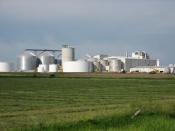Year 12 Chemistry Research Task
9.2 - Production of Materials
�
Describe the dehydration of ethanol to ethylene and identify the need for a catalyst in this process and the catalyst used.
A dehydration reaction is a reaction in which a molecule of water is removed from a compound. The molecule of water is released as one product.
A hydrogen atom and OH group are removed from adjacent carbon atoms to form the water molecule. Each carbon atom has an unpaired electron and both of them join up to form a carbon-carbon double bond.
The dehydration of ethanol involves ethanol being heated to about 180oC with concentrated sulfuric acid or phosphoric acid used a catalyst and dehydrating agent. A catalyst is needed in order to speed up the reaction and lower the activation energy required for the reaction to take place.
H+
CH3CH2OH(l) â CH2CH2(g) + H2O(l)�
Describe the addition of water to ethylene resulting in the production of ethanol and identify the need for a catalyst in this process and the catalyst used.
A hydration reaction is a reaction in which a water molecule is added to a compound.
In the hydration of ethylene, one of the two carbon-carbon bonds is broken. A hydrogen atom of the water molecule is added to a carbon atom. The OH group of the water molecule is added to another carbon atom.
The hydration of ethylene is an example of an addition reaction with alkenes.
The hydration of ethanol involves ethanol being heated at 300oC with dilute aqueous sulfuric acid or phosphoric acid used a catalyst and hydrating agent. A catalyst is needed in order to speed up the reaction and lower the activation energy required for the reaction to take place. An acid catalyst is required because the water molecule itself...


